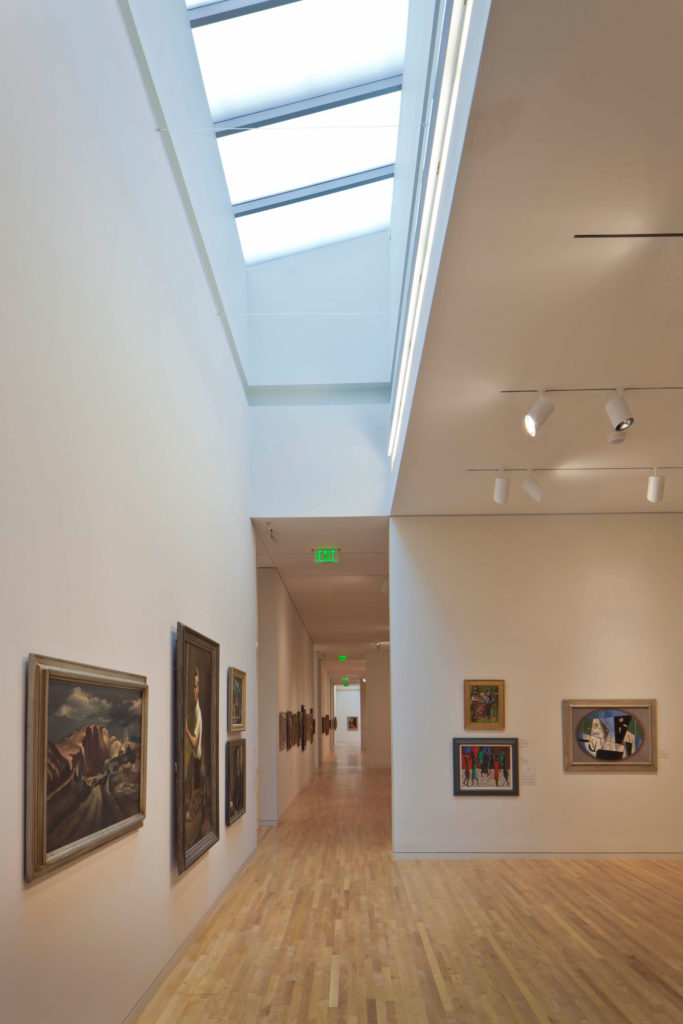Athens, Ga. – The newly expanded and remodeled building which houses the Georgia Museum of Art has been officially LEED-Certified Gold.
LEED, or Leadership in Energy and Environmental Design, is an independent, third party verification that indicates a project is constructed using strategies and materials that promote sustainable development, water savings, energy efficiency and indoor air quality. The facility opened the doors to its new location Jan. 29, 2011.
Early on, GMOA staff worked closely with the Office of University Architects to achieve the museum’s programmatic and sustainability goals, while designing a structure that would nearly triple the museum’s gallery space and improve the environmental quality of the site. The design team elected to employ an independent firm, SSRCx, to track, document, verify and advise on how to achieve LEED points. Throughout the design and construction process, the design architect, Gluckman-Mayner Architects, New York; the architect of record, Stanley Beaman & Sears, Atlanta; Holder Construction; the university’s architects; and museum staff worked to weigh short-term and life-cycle costs to achieve their sustainability goals, ensure proper documentation for LEED credit, and meet budget and programmatic restraints.
Annelies Mondi, deputy director of the museum, who was in charge of the building project, said, “As students, staff and faculty of the university, we should be proud that Georgia’s flagship institution of higher education supports LEED construction on campus. The Gold certification awarded to the Georgia Museum of Art is one of several indications of UGA’s commitment to using our state’s resources more efficiently and providing a healthier environment for all.”
To reduce negative impact to the site, the addition was built largely over the location of an existing parking lot. This decision minimized the net addition of impervious surface and limited construction activities to terrain already disturbed by grading, paving and tree removal. Reflective roofing materials lessen the heat-island effect most often associated with asphalt parking or roofing materials, and significant green space was added. Large rain gardens on site slow and clean rainwater run-off before releasing it into Lily Branch and the North Oconee River.
More than 91 percent of the construction waste was salvaged or recycled, with much of it reused on site or in other campus projects. Furthermore, preference was given to building materials containing recycled content or those extracted or manufactured within the region.
The new museum also is a model for water efficiency on campus. Buried adjacent to the new addition are two 25,000-gallon cisterns that collect rainwater and condensation produced by the museum’s air-conditioning system. These cisterns were designed to supply water to a fountain in the museum’s Jane and Harry Willson Sculpture Garden and for irrigation. The building’s landscape incorporates native plants and a high-efficiency irrigation system that is projected to reduce water use significantly. As more condensation will be produced and collected during the summer months when irrigation needs are the highest, the use of potable water in irrigation should be eliminated. The museum also installed low-flow plumbing fixtures that will reduce water consumption by 44 percent.
Efficient and sophisticated mechanical systems and a well-crafted exterior provide an optimal environment for the museum’s collections and temporary exhibitions and achieve a savings of 18.5 percent every year in energy costs when compared to conventional, similar structures. The addition also allows significant daylight into the corridors and galleries. Direct daylight can be harmful to works of art, but natural light enters the new galleries from deeply recessed and shaded skylights that render all natural light indirect. Other indirect light spills from generous daylight in adjacent corridors, again rendered indirect by the orientation and placement of the galleries. Visitors sense a natural light but its source is obscure.
The design team improved indoor air quality by selecting refrigerants and HVAC equipment that minimized emissions of ozone-depleting compounds; choosing low-VOC paints, adhesives and sealants; and enrolling the building in UGA’s award winning green cleaning program, which improves indoor air quality by replacing hazardous cleaning chemicals with safer, environmentally-friendly products.
The Georgia Museum of Art joins UGA’s Tate II and building 1516 (the new residence hall) in becoming LEED Gold-Certified.
Museum Information
Partial support for the exhibitions and programs at the Georgia Museum of Art is provided by the Georgia Council for the Arts through appropriations of the Georgia General Assembly. The council is a partner agency of the National Endowment for the Arts. Individuals, foundations and corporations provide additional museum support through their gifts to the University of Georgia Foundation. The Georgia Museum of Art is located in the Performing and Visual Arts Complex on the East Campus of the University of Georgia. The address is 90 Carlton Street, University of Georgia, Athens, Ga. 30602-6719. For more information, including hours, see www.georgiamuseum.org or call 706/542-GMOA (4662).
##
